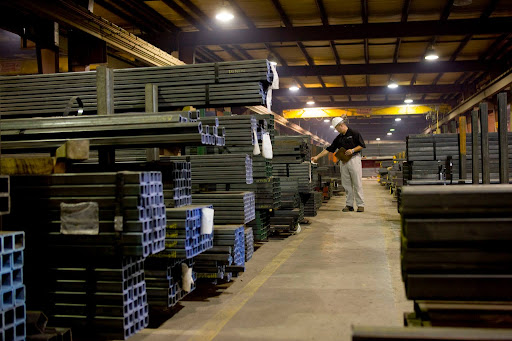Comparing Types of Steel Channel, Tubes, and Beams in Framing Applications
Selecting the appropriate steel profile is critical to achieving strength, longevity, and installation efficiency in structural framing applications. Various types of steel channel, steel tubes, and steel beams can each provide distinct structural advantages, fabrication flexibility, and other benefits in certain uses. Understanding how these steel shapes compare helps professionals make informed decisions tailored to specific framing applications.

Steel Channels: Lightweight Versatility That Fits the Frame
Steel channels are a reliable and versatile option in structural framing systems. They feature a vertical web and horizontal flanges that form either a “C” or “U” shape. Channel steel is common in applications requiring uniform load distribution and easy attachment to flat surfaces.
One of the most significant advantages of steel channels is their ease of fabrication and installation. Their open profile allows for simple bolting, welding, or riveting to structural assemblies or other components. In applications such as roof purlins, wall studs, equipment supports, or temporary frameworks, channels provide a cost-effective and structurally reliable solution.
However, channels do have limitations. Because of their open shape, they are more prone to torsional twisting compared to closed profiles like tubes. For framing systems exposed to significant lateral or torsional forces, channels alone may not offer enough stiffness. That said, their low weight, straightforward connectivity, and compatibility with common fasteners continue to make channels an excellent option for many light-to-medium duty framing needs.
Steel Tubes: Strength, Symmetry, and Style in One Profile
Steel tubes, including square, rectangular, and round profiles, are a frequent choice when structural performance and aesthetics must go hand in hand. Their closed, hollow geometry offers strength in multiple directions and resists torsion far better than open-profile steel products. This resistance makes tubes ideal for frames subject to lateral loads, seismic activity, or rotational stress.
Steel tubes are useful in architectural framing applications, curtain wall systems, and load-bearing columns. Uniform dimensions and clean surfaces provide a modern visual appeal, and tubes’ hollow centers allow for integrating electrical or plumbing systems in modular structures.
Structural steel tubes can be more expensive to fabricate, however. Cutting, joining, or welding steel tubes often requires specialized tools or added labor. Performance and design benefits offset extra costs in some cases, but engineers should carefully evaluate whether their torsional resistance or closed profile is necessary for the frame’s intended use.
Structural Beams: Built to Carry the Heaviest Loads
Beams remain foundational in heavy framing applications. While the I-beam is the most recognized profile, H-beams also offer tailored benefits. I-beams consist of a central vertical web flanked by two horizontal flanges, delivering strength against vertical bending forces. H-beams, with wider flanges and thicker webs, offer higher load capacities in support columns.
Beams generally require heavy equipment for installation due to their robust size and weight, which makes them less ideal for smaller builds or job sites with access limitations.
Compared to steel channels or tubes, beams offer unmatched strength and stiffness under vertical load, but they lack the torsional resistance of a tube or the lightweight flexibility of a channel. Beams work best in large framing systems where their size and support capabilities justify the increased weight and handling requirements.
Balancing Performance and Practicality: Comparing Types of Steel Channels, Tubes, and Beams
Each steel profile offers unique advantages in framing applications. Steel channels provide simplicity, flexibility, and affordability, especially in wall and roof framing. Tubes add torsional resistance and aesthetics, making them well-suited for architectural and exposed framing. Beams, with their high load-bearing capacity, serve as the backbone for heavy-duty and long-span systems.
| PROFILE | STRENGTH UNDER LOAD | TORSIONAL RESISTANCE | EASE OF FABRICATION | TYPICAL USE CASES |
|---|---|---|---|---|
| C Channel | Moderate | Moderate | High | Stud walls, roof purlins, floor joists, equipment supports |
| U Channel | Light to Moderate | Low | Very High | Trims, light-duty framing, edge protection |
| Steel Tube | High | Very High | Moderate | Architectural framing, load-bearing columns, modular builds |
| I-Beam | Very High | Low | Low | Long-span beams, bridges, mezzanines |
| H-Beam | Extremely High | Low to Moderate | Low | Support columns, heavy industrial frameworks |
When selecting between different types of steel channel, tubes, and beams, project teams should consider more than just strength. Load direction, connection complexity, installation methods, aesthetic needs, and cost all influence which steel profile is the most appropriate. For lighter framing or flexible design needs, steel channels often offer the best combination of function and efficiency.
Source Smart and Frame Strong with Westfield Steel
Sourcing the correct steel framing profile begins with understanding its role in your structure. With millions of pieces in inventory across three centrally located Midwest facilities, Westfield Steel provides a wide range of standard and custom steel channel options ready for fabrication. Our steel experts work closely with manufacturers, architects, and engineers to fabricate steel channels to precise dimensions, hole patterns, and end conditions.
From framing new warehouse systems to reinforcing modular units, Westfield Steel helps ensure your structure stands strong and stays on schedule. Reach out today to speak with one of our steel experts or to request a free, no-obligation quote tailored to your steel channel needs and framing projects.
Back